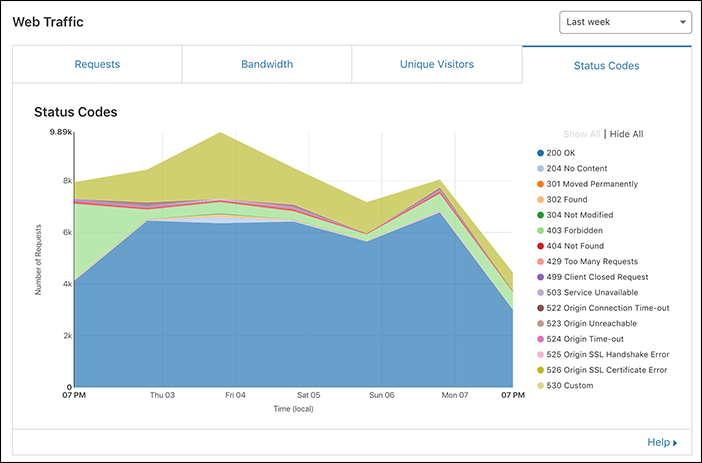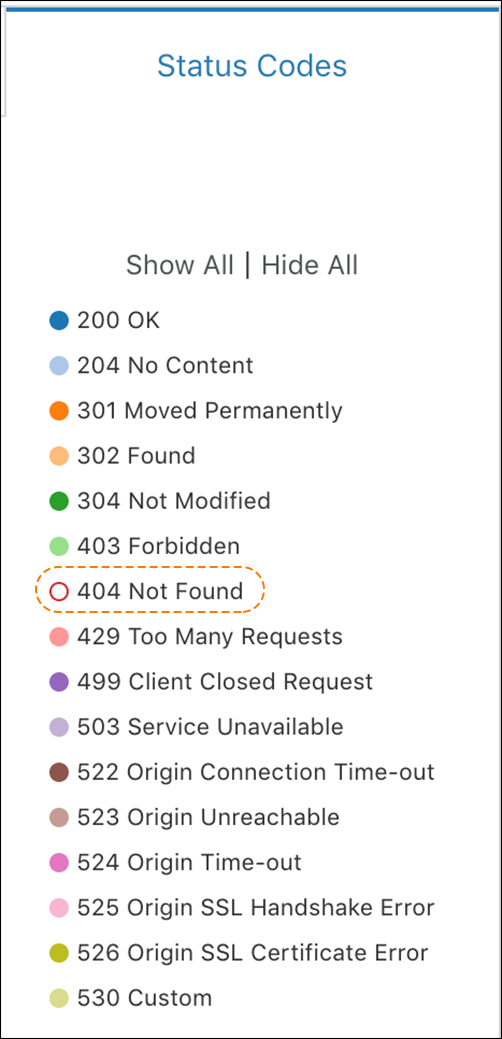Status codes
Status Codes metrics in the Cloudflare dashboard Analytics app provide customers with a deeper insight into the distribution of errors that are occurring on their website per data center. A data center facility is where Cloudflare runs its servers that make up our edge network ( current locations).
HTTP status codes that appear in a response passing through our edge are displayed in analytics. These codes can be split into three groups: ‘edge network errors’, ‘origin errors’ and ‘52x errors’.
Errors that originate from our edge servers -such as 502, 503, and 504 with ‘Cloudflare’- are not reported as part of the error analytics. However, errors such as 52x, can inform you about problems with your server.

Edge Network errors
400- Bad Request intercepted at the Cloudflare Edge (for example, missing or bad HTTP header)403- Security functionality (for example, Web Application Firewall, Browser Integrity Check, Cloudflare challenges, and most 1xxx error codes)409- DNS errors typically in the form of 1000 or 1001 error code413- File size upload exceeded the maximum size allowed (configured in the dashboard under Network > Maximum Upload Size.)444- Used by Nginx to indicate that the server has returned no information to the client, and closed the connection. This error code is internal to Nginx and is not returned to the client.499- Used by Nginx to indicate when a connection has been closed by the client while the server is still processing its request, making the server unable to send a status code back.
Origin errors
400- Origin rejected the request due to bad, or unsupported syntax sent by the application.404- Only if the origin triggered a 404 response for a request.4xx50x
503 errors
We do count 503 errors from your origin that are passed as a response from the edge, though in this version 503 errors from the edge have multiple potential sources.
- Your origin server had a
503. We received this from the origin and the status code was in the response from the on the edge - WebSocket rate-limit error
52x errors
520- This is essentially a “catch-all” response for when the origin server returns something unexpected, or something that is not tolerated/cannot be interpreted by our edge (that is, protocol violation or empty response).522- Our edge could not establish a TCP connection to the origin server.523- Origin server is unreachable (for example, the origin IP changed but DNS was not updated, or due to network issues between our edge and the origin).524- Our edge established a TCP connection, but the origin did not reply with a HTTP response before the connection timed out.
Status codes
The status codes section shows:
- The error code returned in the response
- The time-stamp for the “bucket” you selected
- The total count of that specific error code for that time-stamp
- The % of total requests that serves that error
You can filter out specific error(s) by selecting one or more in the legend. Once you select an error it will be greyed out in the drop-down menu, and the error will no longer display as part of the graph.

In this example, by selecting 404 in the legend we removed it from being displayed in the UI.